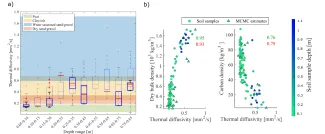An approach combining thermal modeling, Bayesian inference, and soil temperature time series with vertical spatial resolution reveals under what conditions soil thermal diffusivity can be reliably inferred.
Improving the quantification of soil thermal properties is key to achieving a better prediction of soil hydro-biogeochemical processes and their responses to changes in atmospheric forcing. Obtaining such information at numerous locations with conventional soil sampling is challenging. The increasing availability of vertically resolved temperature sensor arrays offers the potential for improving the estimation of soil thermal properties from temperature time series. In this study, the team developed a parameter estimation approach based on a combination of thermal modeling, Bayesian inference and Markov chain Monte Carlo (MCMC) simulation to estimate thermal diffusivity and its uncertainty over time, at numerous locations, and at an unprecedented vertical spatial resolution (i.e., down to 5 to 10 cm vertical resolution) from soil temperature time series. Also, the team assessed under which environmental conditions, temperature sensor characteristics, and deployment geometries soil thermal diffusivity can be reliably inferred. Synthetic experiments show that in the presence of median diurnal fluctuations ≥1.5°C at 5 cm below the ground surface, temperature gradients >2°C m-1, and a sliding time window of at least 4 days, the proposed method provides reliable depth-resolved thermal diffusivity estimates with percentage errors ≤10%. Reliable thermal diffusivity under such environmental conditions also requires temperature sensors to be spaced with accuracy to a few millimeters, and with a bias defined by a standard deviation ≤0.01°C. The application of the developed approach to field data acquired on the Seward Peninsula of Alaska indicates significant repeatability in results and similarity with independent measurements, as well as the ability to use a sliding time window to estimate temporal changes in soil thermal diffusivity, as needed to potentially capture changes in bulk density or water content. These findings represent a critical step to guide the development of cost-effective methodologies to estimate soil thermal and physical properties at numerous locations.
Citation: Brunetti, C., J. lamb, S. Wielandt, S. Uhlmann, I. Shirley, P. McClure, and B. Dafflon. 2022. “Probabilistic estimation of depth-resolved profiles of soil thermal diffusivity from temperature time series.” Earth Surface Dynamics 10: 687–704. https://doi.org/10.5194/esurf-10-687-2022.
Estimation of soil thermal diffusivity and related physical properties. (A) Range of thermal diffusivity measured from soil samples (bold boxes) and inferred from MCMC inversions (thin boxes) across a watershed about 27 mi northwest of Nome, Alaska. (B) Relationship between soil thermal diffusivity and dry bulk and carbon density for the soil samples (dots with distance correlation value shown in green) and additional comparison with collocated MCMC-inferred (triangles with distance correlation values shown in red) thermal diffusivity.


